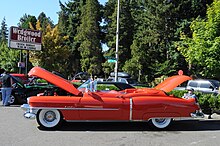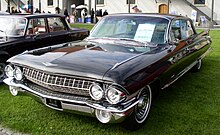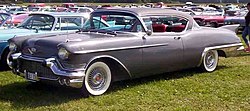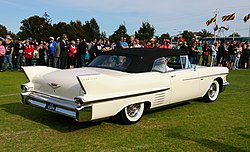Cadillac Series 62
| Cadillac Series 62 | |
|---|---|
luxury car | |
| Layout | Front-engine, rear-wheel-drive |
| Chronology | |
| Predecessor | Cadillac Series 61[1] Cadillac Series 65[1] |
| Successor | Cadillac Calais Cadillac de Ville |
The Cadillac Series 40-62 is a series of cars which was produced by
First generation (1940–1941)
| First generation | ||
|---|---|---|
Curb weight | 4,100–4,400 lb (1,900–2,000 kg) | |



The
These changes were carried over to the Cadillac Sixty Special borrowing a naming convention from the entry-level Buick Special.[1] The styling feature distinguishing all V-8 Cadillacs was once again the grille. Although grilles had the same pointed shape as in 1939, the grille bars were heavier and fewer in number. Two sets of louver bars appeared on each side of the hood. Running boards were a no cost option. The Series 62 was available as a club coupe or a sedan, with 2-door and 4-door convertibles introduced mid-year. Sales totaled 5,903 in its inaugural year accounting for about 45% of Cadillac's sales. The 2-passenger Coupe was listed for US$1,685 ($36,646 in 2023 dollars [5]), the 5-passenger Touring Sedan was US$1,745 ($37,951 in 2023 dollars [5]), and the 4-door Convertible Sedan was US$2,195 ($47,737 in 2023 dollars [5]).[1] While the 2-door could only accommodate 2 passengers, they were labeled as "coupes" instead of the more accurate roadster, then in 1941 passenger capacity increased to four.[1]
In 1941, the one piece hood came down lower in the front, included the side panels and extended sideways to the fenders. A single rectangular panel of louver trim was used on each side of the hood. The rectangular grille was wide, vertical, and bulged forward in the middle. Rectangular parking lights were built into the top outer corners of the grille. Headlights were now built into the nose of the fenders, and provision for built in accessory fog lights was provided under the headlights. Three chrome spears appeared on the rear section of all four fenders. Rear fender skirts were standard. The Series 62 offered the only 4-door convertible built by Cadillac in 1941 and it would be the last time this bodystyle was ever made by the marque. All Cadillacs shared the same 346 cu in (5.7 L) 135 hp (101 kW) L-head V8 that year, with power rising to 150 hp (112 kW).[1]
Sales more than quadrupled to 24,734, accounting for 37% of Cadillac sales in a sales year that well more than doubled the previous Cadillac sales rate record set during the two model years of 1926–27, in part due to the huge popularity of the new Series 61. Evidently the new "torpedo" style with its low streamlined runningboardless bodies and expansive shoulder room had proved a big hit. The following model year, abbreviated as it was by a world war, would set no such sales record.[1]
Second generation (1942, 1946-1947)
| Second generation | ||
|---|---|---|
Curb weight | 4,300–4,700 lb (2,000–2,100 kg) | |



The grille became more massive in 1942, with even fewer bars and was the beginning of the traditional "egg crate" appearance that all future products adopted. Parking lights became round and fog light sockets became rectangular and were included in the grille area. A bullet shape appeared on the tops of the bumper guards. Fenders were rounded and longer and no longer featured side ventilation grilles. Front fender character outlines now extended into the front doors, a feature GM called "Airfoil" for all products for that year, and rear fenders extended forward into the rear door.[1] The new fenders had heavy moldings along the sides. The appearance was more expressive and expansive in comparison to the all-new Packard Clipper introduced at the same time. A new fresh air ventilating system with air ducts leading from the grille replaced cowl ventilators. Handbrake control was changed from lever to tee-shaped pull handle. Radiator shutter control of engine temperature was replaced by a blocking type thermostat in the water return fitting in the radiator. Vehicles that were built until February 1942 could be identified as lacking chrome trim starting in January when it was prohibited due to wartime production and trim pieces including bumpers were painted.[1]
The first postwar Cadillac rolled off the line on October 7, 1945, and for several months, only Series 62s were produced. 1946 Cadillacs were not significantly altered from 1942 outside a few styling changes and the addition of a negative ground battery. The Series 62 retained the same lineup of body styles as in 1942—coupe, sedan, and convertible, and 18,565 total were produced for the model year, approximately 65% of Cadillac's total 1946 output of 29,000 vehicles. Resuming civilian production was a difficult task for the entire automobile industry and demand for new cars much exceeded supply. Cadillac had as many as 100,000 unfilled orders into 1947. Due to materials shortages, some Cadillacs shipped from the factory with wooden bumpers, dealers being expected to install proper ones as they became available. Postwar inflation pushed the sticker price of a 1946 Cadillac over $1000 higher than 1942.
In 1946, the Series 62 used GM's
The 1947 models received minor styling changes and the addition of Hydro-Lectric window lifts on the Series 62 convertible, which remained the sole ragtop in Cadillac's lineup. Polished metal stone guards on the fenders replaced the rubber ones used on 1946 models. As before, Series 62s remained Cadillac's bread-and-butter lineup with 39,834 produced, 84% of the make's total 1947 volume.
Third generation (1948–1953)

| Third generation | ||
|---|---|---|
Curb weight | 4,400–5,000 lb (2,000–2,300 kg) | |




The first all-new postwar Cadillacs arrived in 1948, sporting tail fins inspired by the
The new Cadillac OHV V8 was the big news for 1949, with minor trim differences otherwise. This 331 cu in (5.4 L) engine produced 160 hp (119 kW) and weighed 200 pounds less than the old flathead V8 in addition to being shorter and lower. The 331 V8 could also handle higher compression levels to take advantage of improved, higher octane postwar gasoline formulations. The major difference between Series 61 and Series 62 models of similar body style was minor trim variations. The higher-priced series again had grooved, front fender stone shields and bright rocker panel moldings. Chevrons below the taillights were no longer seen. The convertible was an exclusive offering. A heater was optional.[7] Sales reached a record 55,643.
The Cadillac Series 62
55,643 Series 62 Cadillacs were produced in 1949 out of a total volume of 92,554 vehicles.
For 1950, major styling changes were performed. The cars were lower and sleeker, with longer hoods, and one-piece windshields were fitted. Hydra Matic transmission was now standard. The Series 61 was again a short wheelbase model, having been reduced to 122 in (3099 mm). Sales set yet another record at 59,818.
Full-length chrome rocker panels set off the 1951 model, and the Coupe de Ville was now marked with noticeably-improved trim, including Coupe de Ville script on the rear roof pillar. Sales were 81,844, or a record of over 74% of all Cadillacs sold. Popular Mechanics reported about 12-MPG at 45 mph.[9]
In 1952, to commemorate the 50th anniversary of Cadillac, the V-shaped hood and deck emblems were done as gold castings. The Series 62 sedan was also characterized by a higher rear deck lid contour. This provided additional luggage space. Back up lights were now standard equipment and were incorporated in the taillights. The grille wraparound panels were redesigned once again having broad chrome trim below each headlight with side scoop styling and gold-colored winged emblem mounted in the center. At the rear all Cadillacs adopted a through the bumper dual exhaust system. Deck ornamentation took the form of a Cadillac crest over a broad golden "V". New standard features included self-winding clocks, improved direction signal indicators, glare proof mirrors, stannate treated pistons, and four barrel carburetion. Engine output for the 331 was up to 190 hp (142 kW). Sales fell to 70,255, but with the Series 61 out of the way, Series 62 sales accounted for a record 78% of all Cadillacs.
The 1953 Series 62 saw a redesigned grille with heavier integral bumper and bumper guards, the repositioning of parking lamps directly under the headlights, chrome "eyebrow" type headlamp doors, and one piece rear windows without division bars. Wheel discs were fashioned in an attractive new disced design. Series 62 bodystyles were identified by non louvered rear fenders, the use of thin bright metal underscores on the bottom rear of the cars only and the decoration of both hood and deck lid with Cadillac crests and V-shaped ornaments. The Club Coupe model disappeared. Two door Series 62 were now all hardtops (including the better equipped Coupe de Ville) or convertibles. Another familiar name appeared on 1953's Series 62. The top-of-the-line subseries Eldorado was one of three specialty convertibles produced in 1953 by General Motors, the other two being the Oldsmobile 98 Fiesta and the Buick Roadmaster Skylark. The Eldorado was a limited-edition luxury convertible, and would eventually become its own series. It featured a full assortment of deluxe accessories, including wire wheels, and introduced the wraparound windshield to Cadillac standard production. Sales set a new record at 85,446.
Fourth generation (1954–1956)
| Fourth generation | ||
|---|---|---|
Curb weight | 4,500–5,100 lb (2,000–2,300 kg) | |



The Series 62 included a lower sleeker body, a new cellular grille insert, and inverted gull wing front bumpers and tapered dagmar style bumper guards. Round jet-style dual exhaust outlets were incorporated into the vertical bumper extensions and the rear bumper was entirely redesigned. An
In 1955, the grille was redesigned with wider spaces between the blades and the parking lamps were repositioned beneath directly below the headlights. On the sides of the body the rub-rail moldings formed a right angle with the vertical trim on the rear doors or fenders. This accentuated the character line in the sheet metal. The Florentine curve rear window treatment was adopted for sedans. Three chrome moldings bordered the rear license plate on either side and deck lid decorations consisted of a V-shaped ornament and a Cadillac crest. The Coupe de Ville had a golden script nameplate at the upper body belt just forward of the rear window pillar. The Eldorado sport convertible featured extras such as wide chrome body belt moldings, a distinctive rear fender design, with twin round taillights halfway up the fenders and flatter pointed tailfins. Tubeless tires were a new standard Cadillac feature. Sales reached a record 118,190, accounting for nearly 84% of all Cadillacs sold. Standard equipment included back-up lights, turn signals, and automatic transmission.[12][13]
In 1956, there was a new grille, with finer textured insert, and the repositioning of the parking lights in the bumpers, below the wing guards. Buyers were given an option of the standard satin finish grille or an optional gold finish. Cadillac script was found on the left side. A narrow chrome molding and nine vertical louvers were seen. The Coupe de Ville had a model nameplate and a Cadillac crest on the sides of the front fenders. The Coupe de Ville was joined by the Series 62
Series 62 sales reached an all-time record in 1956 at 134,502 units, accounting for an all-time record 86.4% of all Cadillacs sold. This included 66,818 De Villes and 6050 Eldorados.
In a Popular Mechanics survey of 1956 Series 62 owners, the two most serious complaints: Was one, with 23.7% responding to the survey, slipshod workmanship during assembly; and two, with 22.7% of responses, were transmission problems. The major items they liked, with 35% of responses, was one, riding quality; and two, with 32.7% of responses, power and performance.[17]
Fifth generation (1957–1958)
| Fifth generation | ||
|---|---|---|
Curb weight | 4,800–5,300 lb (2,200–2,400 kg) | |
For 1957, a tubular X-frame without side rails was adopted, which Cadillac claimed resulted in lower body without a loss of usable space and increased torsional strength.
For 1958, there was a new grille featuring multiple round "cleats" at the intersection of the horizontal and vertical members. The grille insert was wider and new bumper guards were positioned lower to the parking lamps. New dual headlamps were used and small chrome fins decorated the front fenders. Tailfins were less pronounced and trim attachments were revised. The word Cadillac appeared in block letters on the fins of base models. On the sides of the car were five longer horizontal wind splits ahead of the unskirted rear wheel housing and front fender horizontal mouldings with crests placed above the trailing edge and no rocker sill trim. The convertible and the De Villes used solid metal trim on the lower half of the conical projection flares, while other models had a thin ridge molding in the same location. On Series 62 Eldorados, a V-shaped ornament and model identification script were mounted to the deck lid. Series 62 Eldorados also had ten vertical chevron slashes ahead of the open rear wheel housings and crest medallions on the flank of the tailfins. Broad, sculptured beauty panels decorated the lower rear quarters on all Series 62 Eldorados and extended around the wheel opening to stretch along the body sills. Standard equipment on all Series 62s was the same as the previous year. All new was an extended deck Series 62 sedan which, along with the Series 62 Sedan deVille, stretched 8.5 inches longer than the regular 4-door Series 62, and a special order Series 62 Eldorado Seville of which only one was actually built. Excluding export sedans and chassis only, the Series 62 offered an all-time record of nine bodystyles this year. The infamous Cadillac Air-Suspension was optional.[19] The following year De Ville and Eldorado were spun off onto their own series.
-
1957 Cadillac Series 62 Sedan
-
1957 Cadillac Series 62 Sedan interior
-
1957 Cadillac Series 62Coupe de Ville
-
1957 Cadillac Series 62 Eldorado Seville
-
1958 Cadillac Series 62 coupe
-
1958 Cadillac Series 62Sedan de Ville
-
1958 Cadillac Series 62 Convertible
-
1958 Cadillac Series 62 Eldorado Biarritz
Sixth generation (1959–1960)
| Sixth generation | ||
|---|---|---|
Curb weight | 4,900–5,100 lb (2,200–2,300 kg) | |





The 1959 Cadillac is remembered for its iconic huge tailfins with dual bullet tail lights. The new model year also saw two distinctive rooflines and roof pillar configurations, new jewel-like grille patterns and matching deck lid beauty panels. For 1959, the Series 62 became the Series 6200.
The 1960 Series 62 had smoother, more restrained styling. General changes included a full-width grille, the elimination of pointed front bumper guards, increased restraint in the application of chrome trim, lower tailfins with oval shaped nacelles and front fender mounted directional indicator lamps. Series 62 models were distinguished by plain fender skirts, thin three-quarter length bodyside spears and Cadillac crests and lettering on short horizontal front fender bars mounted just behind the headlights. Four-window and six-window hardtop sedans were offered again. The former featured a one-piece wraparound backlight and flat-top roof, while the latter had a sloping rear window and roofline. Standard equipment included power brakes, power steering, automatic transmission, dual back-up lamps, windshield wipers, two-speed wipers, wheel discs, outside rearview mirror, vanity mirror and oil filter. The convertible model had power windows and a two-way power seat. Technical highlights were finned rear drums and an X-frame construction. Interiors were done in Fawn, Blue or Gray Cortina Cord or Turquoise, Green, Persian Sand, or Black Caspian cloth with Florentine vinyl bolsters. Convertibles were upholstered in Florentine leather single or two-tone combinations or monochromatic Cardiff leather combinations.
Seventh generation (1961–1964)

| Seventh generation | ||
|---|---|---|
Curb weight | 4,700–4,900 lb (2,100–2,200 kg) | |



Cadillac was restyled and re-engineered for 1961. The new grille slanted back towards both the bumper and the hood lip, along the horizontal plan, and sat between dual headlamps. New forward slanting front pillars with non-wraparound windshield glass were seen. The revised backlight treatment had crisp angular lines with thin pillars on some models and heavier semi-blind quarter roof posts on others. Standard equipment power brakes, power steering, automatic transmission, dual reverse lights, windshield washer, dual speed wipers, wheel discs, plain fender skirts, outside rearview mirror, vanity mirror and oil filter. Rubberized front and rear coil springs replaced the trouble prone air suspension system. Four-barrel induction systems were now the sole power choice and dual exhaust were no longer available.
A mild face lift characterized Cadillac styling trends for 1962. A flatter grille with a thicker horizontal center bar and more delicate cross-hatched insert appeared. Ribbed chrome trim panel, seen ahead of the front wheel housings for 1961, were now replaced with standard cornering lamps[21] and front fender model and series identification badges were eliminated. More massive front bumper end pieces appeared and housed rectangular parking lamps. At the rear tail lamps were now housed in vertical nacelles designed with an angled peak at the center. A vertically ribbed rear beauty panel appeared on the deck lid latch panel. Cadillac script also appeared on the lower left side of the radiator grille. The short-deck hardtop Town Sedan was moved from the Series 6300 to the Series 6200, being replaced by a short-deck Sedan de Ville Park Avenue in the Series 6300.[22] In addition all short deck Cadillac models went from being 6-window sedans for 1961 to 4-window sedans for 1962 and 1963. The Town Sedan would disappear for 1963,[23] with only 4,900 sold (of 134,572 Series 62s in all),[24] though the Sedan de Ville Park Avenue sold even fewer, 4,175 (out of 150,882 De Villes).[25] Standard equipment included all of last year's equipment plus remote controlled outside rearview mirror, five tubeless black wall tires, heater and defroster and front cornering lamps. Cadillac refined the ride and quietness, with more insulation in the floor and behind the firewall.[26]
1963 brought another restyle. Exterior changes imparted a bolder and longer look. Hoods and deck lids were redesigned. The front fenders projected 4.625" further forward than for 1962 while the tailfins were trimmed down somewhat to provide a lower profile. Body side sculpturing was eliminated. The slightly V-shaped radiator grille was taller and now incorporated outer extensions that swept below the flush-fender dual headlamps. Smaller circular front parking lamps were mounted in those extensions. A total of 143 options including bucket seats with wool, leather or nylon upholstery fabrics and wood veneer facings on dash, doors and seatbacks, set an all-time record for interior appointment choices. Standard equipment was the same as the previous year. Convertibles were equipped with additional features. The engine displacement and output remained the same, 390 cu in (6.4 L) and 325 hp (242 kW).[27]
A minor facelift for 1964 featured a new bi-angular grille that formed a V-shape along both its vertical and horizontal planes. The main horizontal grille bar was now carried around the body sides. Outer grille extension panels again housed the parking and cornering lamps. It was the 17th consecutive year for the Cadillac tailfins with a new fine-blade design carrying on the tradition. Performance improvements including a larger V-8 were the dominant changes for the model run. Equipment features were same as in 1963 for the most part. Comfort Control, a completely automatic heating and air conditioning system controlled by a dial thermostat on the instrument panel, was introduced as an industry first. The engine was bumped to 429 cu in (7 L), with 340 hp (253.5 kW) available. In its final year only 35,079 Series 62s were sold, the smallest number since 1946 and little more than a quarter of their all-time sales record in 1956. The 62 convertible was dropped for 1964.
The Series 62 (née 6200) designation was dropped after 1964. Cadillac's entry level car was renamed Calais for 1965–1976.
References
- ^ ISBN 0-87341-478-0.
- ^ 1940 Cadillac brochure, www.lov2xlr8.no Retrieved 2016-07-08.
- ^ 1941 Cadillac brochure, www.lov2xlr8.no Retrieved 2016-07-08.
- ^ ISBN 0873492897.
- ^ a b c d 1634–1699: McCusker, J. J. (1997). How Much Is That in Real Money? A Historical Price Index for Use as a Deflator of Money Values in the Economy of the United States: Addenda et Corrigenda (PDF). American Antiquarian Society. 1700–1799: McCusker, J. J. (1992). How Much Is That in Real Money? A Historical Price Index for Use as a Deflator of Money Values in the Economy of the United States (PDF). American Antiquarian Society. 1800–present: Federal Reserve Bank of Minneapolis. "Consumer Price Index (estimate) 1800–". Retrieved February 29, 2024.
- ^ "Directory Index: Cadillac/1948_Cadillac/1948_Cadillac_Brochure". Oldcarbrochures.com. Retrieved 2011-11-20.
- ^ "Directory Index: Cadillac/1949_Cadillac/1949_Cadillac_Brochure". Oldcarbrochures.com. Retrieved 2011-11-20.
- ^ ISBN 0-87341-521-3.
- ISSN 0032-4558. Retrieved 2017-01-08.
- ^ ISSN 0032-4558. Retrieved 2017-01-08.
- ^ Popular Mechanics - Google Boeken. Hearst Magazines. September 1954. Retrieved 2012-10-14.
- ^ "Directory Index: Cadillac/1955_Cadillac/1955_Cadillac_Brochure". Oldcarbrochures.com. Retrieved 2012-10-14.
- ^ "Directory Index: Cadillac/1955_Cadillac/1955_Cadillac_Brochure". Oldcarbrochures.com. Retrieved 2012-10-14.
- ^ "Directory Index: Cadillac/1956_Cadillac/1956_Cadillac_Brochure". Oldcarbrochures.com. Retrieved 2012-10-14.
- ^ Popular Mechanics. April 1956. p. 105. Retrieved 2012-10-14 – via Internet Archive.
cadillac.
- ISSN 0032-4558. Retrieved 2017-01-08.
- ^ "Owners Report: "Owners Praise Cadillac's Performance But Complain of Transmission Trouble." Popular Mechanics, April 1956, pp. 104-108/258
- ^ Cadillac data book 1957. Cadillac Division of General Motors. 1957. Retrieved 13 October 2019.
- ^ "Directory Index: Cadillac/1958_Cadillac/1958_Cadillac_Brochure_1". Oldcarbrochures.com. Retrieved 2012-10-14.
- ^ "Directory Index: Cadillac/1962_Cadillac/1962_Cadillac_Brochure". Oldcarbrochures.com. Retrieved 2011-11-20.
- ^ "Directory Index: Cadillac/1962_Cadillac/1962_Cadillac_Brochure". Oldcarbrochures.com. Retrieved 2012-10-14.
- ^ Flory, J. "Kelly", Jr. American Cars 1960–1972 (Jefferson, NC: McFarland & Coy, 2004), p.147.
- ^ Flory, p.210.
- ^ Flory, pp.148 & 212.
- ^ Flory, pp.149 & 212.
- ^ Flory, p.147.
- ^ Flory, p.211.










